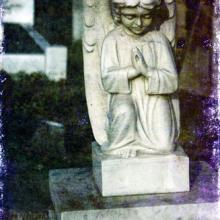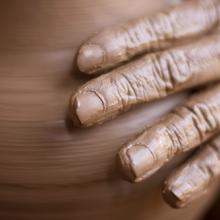life
For some months now, I have been ruminating on the writer John Podhoretz’s eulogy in Commentary magazine for his sister Rachel Abrams upon her death, from stomach cancer, at age 62. Commentary effectively being the Podhoretz family house organ, and the Podhoretzes effectively being the mythological family of the origin of neoconservatism, the essay would be of interest to anyone interested in cultural and religious sociology — or at least to me.
I, too, come from a family that has also tended to think of itself in somewhat mythological, contrarian terms — This is what Langstons are like — so a meditation from the heart of another large, bustling family is an immediate and natural draw for me.
But lay that all aside. The eulogy wins, and haunts, because it is the passionate remembrance of a sister by her brother. Despite their being part of a prominent East Coast family, its focus is relentlessly on the small acts of family and home that transfigure quotidian existence. Podhoretz dwells lovingly on Rachel as a housewife, a lifetime foul-mouth, an exuberant and dedicated mother, an artist, and finally a writer who let loose with political commentary in her late fifties as online blogs began gathering steam.
“I loved you, Rachel,” he concludes poignantly, in words I could read over and over. “I liked you. And oh, oh, oh, how I admired you.”
So much of that poignancy is derived from direct address to his sister, who is no longer there to receive it. Having just hit 45, Dante comes to mind: midway-through-the-journey-of-our-life-I found myself within a dark wood for the right way had been lost. Who can know how our days are numbered? The lesson for me is that I should tell of how I love my brother John, even as he lives.
A few weeks ago, I asked folks on Twitter, and specifically, my colleague Amy Simpson, who has recently published a book on mental illness and the mission of the church:
What do you think about the way people use words like “bipolar,” “crazy,” and “manic” when they really mean “moody,” “energetic,” “quirky” and even “fun?"
It’s part of a pattern I’ve noticed lately — and maybe you’ve noticed it too.
People with beautiful head shots, flawlessly designed websites, and enviable accomplishments insist that they are really just a ‘mess.’ Or that their families are ‘crazy.’ Or that their homes and lives are every bit as complicated and frustrating as everyone else’s … meanwhile, their Instagram feeds show nothing but beauty; if ‘chaos’ is there, it’s only ever of the picturesque kind.
There are no birdcages sprouting stalagmites and stalactites of bird droppings. There are no snotty-nosed, unwashed, half-dressed, hungry children who’ve never visited a dentist in their lives. There is food in the fridge and on the table, and it isn’t even growing mold or crawling with roaches or undulating with maggots. In fact, it’s from Trader Joe’s and may even be organic! There is no broken glass or police officers showing up because the neighbors heard screaming. There is electricity and running water and indoor toilets.
Yeah, there’s raised voices and tempers and conflicts. But that makes you human. Not crazy. Not dysfunctional. Not “a mess.”
And fallen, fallen light renew!
—William Blake
Thou, this humid cloak at dusk, a blue
Air flattened, smoldering the same
Field for years. Oh, Thou—this hardened name
For You not joyously sprung, not grown to grace
"HOW DID THIS HAPPEN?" pondered the middle-aged woman as she panted up the road to her village of Sychar, water jar forgotten. “How did we get into this heavy theological conversation from a simple request for a drink of water? Sometimes conversations take sharp turns, but this is just too bizarre. I’ve known a number of men in my life, but only the crazy ones told me they were the messiah! Better check this out with the town elders.”
In contrast to the approximately 800 references to water in the Hebrew Bible, the New Testament is relatively spare. A friend explained the difference. The ancient Hebrews emerged from the eastern desert cultures of Egypt and Babylonia (now Iraq), which built their empires around rivers and where water was scarce and precious. But the New Testament writers were oriented toward the wetter West, where seafaring Greeks and Romans had appropriated the Mediterranean Sea as their major mode of transportation and conquest. For example, even though the book of Acts only mentions the word “water” in reference to baptism, the early missionary movement depended on travel by ship to spread the gospel message.
Water in the synoptic gospels
All four gospels introduce us to John the Baptist down by the Jordan River, who dunks in its flowing water those who repent from sin as a symbol of their cleansing. After John moves offstage, the synoptic gospels center much of Jesus’ activity in the towns around the Sea of Galilee. Here he not only teaches from a boat (Matthew 13:2; Luke 5:3), but he and his disciples travel in it from one side of the lake to the other, which includes a miraculous walk on and rebuking of the stormy waves (Matthew 14:22-27; Mark 6:47-52; Luke 8:22-25). Other references to water are few and sometimes incidental.
Meet “Our Lady of Perpetual Exhaustion,” a saint everyone probably can relate to.
The chaos of everyday life and the methods we use to overcome it are on display at the “Our Lady of Perpetual Exhaustion” exhibit in two D.C. galleries.
“We all have coping mechanisms,” said Cynthia Farrell Johnson, creator of the exhibit’s theme. “And for most of us, part of our coping mechanism is our spiritual life.”
Have we missed those moments where God is hitting us over the head by using people to continue the work of God in the world? Has the church been so focused on bodies, babies, and baptisms that we have failed to see the goodness of God outside the four walls of the church?
I talk to people nearly every day about the presence of God in the world. I speak of how God knows us, cares for us and is abiding with humanity in every time and place. But as with most things, they are easier said than done. Sometimes it takes something drastic to get our attention instead of trying to navigate this thing called life alone.
For one to actually contemplate the presence of God in the world is a bit overwhelming; For one to actually contemplate the presence of God in the world is a bit overwhelming; God is present in every aspect of human life — from the trees, to the clouds, to the faces of people we interact with each day. They are all created by the same hands of the same God.
Biblical writers suggest that God loves a holy mess. They compare God’s creative spirit to a strong wind, and we all know what happens when a powerful wind blows through our windows or through our lives — everything gets upended! One image in Genesis has God scooping up a bit of earth to create us. Yes, God had to get some dirt under the fingernails in order to bring us about.
Jesus was creative in how he touched and healed people, often making himself ritually unclean in the process. He embraced his uncleanliness.
Sadly, many religious institutions discourage us from doing the same.
GORDON COSBY was perhaps the most Christian human being I have known. But he would always be the first to raise serious questions about what it meant to be a “Christian” and lived a different life than many of his fellow pastors and church leaders who call themselves Christian. Gordon was happier just calling himself a follower of Jesus. He always told people who wanted to call him “reverend” to just say “Gordon.”
No one wants to talk about death at the dinner table, at a soccer game, or at a party, says Lizzy Miles, a social worker in Columbus, Ohio.
But sometimes people need to talk about the “taboo” topic and when that happens, they might not be able to find someone who will listen, she says.
“Whenever people hear I’m a hospice worker, they talk to me about death. It doesn’t matter if I’m on an airplane, gambling in Las Vegas, or in a grocery store line,” she said. “I really see firsthand the need to let people talk. It’s my gift to others.”
Her gift sparked the birth of “death cafes” in the U.S., a trend that started in England and is about to take off across America, she said.
The common good is not only about politics. The common good is about life and how we live it. It is ultimately about how we are all connected. It is about how our love or lack of love affects our families, our neighbors, our communities, our cities, our nation, and our world.
The common good is about personal brokenness. Have we taken the time to let Jesus come in and heal the wounds that distort the image of God within of us — wounds that drive daughters and sons, mothers and fathers to self-destruction? Have we taken the time to let the Great Physician heal the personal wounds that break families and friendships, slicing the central fabric of society? We are all connected.
Many of the great Christian thinkers throughout our history have seen that goodness, by its very nature, is diffusive of itself. That is, goodness is such that it pours itself out. To the degree to which I am good, I share that goodness with others to the same degree. The doctrine of creation is often seen in this light. God’s goodness is perfect and as such it is poured out naturally and freely to God’s creation. Goodness, in a word, is generous.
While thinking about immigration, I began to ask myself what this feature of goodness implies. How does the fact that goodness is diffusive of itself relate to my treatment of others, and especially to my treatment of those who, through no fault of their own, simply lack some of the basic goods that I have in abundance? Well, the answer seemed fairly obvious. My basic disposition toward my things and even myself must be one of generosity. Now we can argue over the fine points regarding this or that governmental policy, but we must recognize what we have and cultivate a deep desire to share it with others. Sharing our wealth, our food, our clothing is, I think, merely the first step towards becoming generous.
Water tower located in Pleasantville, Iowa. By Ashton B Crew for Photo taken for www.randomiowa.com. Via Wikimedia Commons
In some way or other, I think it’s safe to say that we all have a kind of nostalgia for the innocence and purity of the Garden of Eden before what we call “the fall.” We have a sense that we are not supposed to be outside the gates of the Garden … out here. At the expulsion of the man and the woman in the story from Genesis, the cherubim (angels) are posted at the gate to be sure that those who have been expelled cannot get back in. The cherubim and a twirling, flaming sword keep Adam, Eve — you, me, all of us — on this side of the gate, outside the Garden of Eden.
Well it’s a story, of course, but isn’t it our story? Nostalgic for a world where nothing ever goes wrong. But illness comes, a marriage goes bad, a relationship with someone you love falls apart just when you think it’s to lead to something more permanent, you lose a job, you suffer depression, you suffer from an illness, you’re left alone in grief over the loss of a loved one. Or you yourself are dying, and there are wars and rumors of wars. We watch the children and wish that we could protect them, but we can’t, even though we are parents and grandchildren, aunts and uncles. Out here, outside the Garden, it’s rough sometimes.
WE WERE LOOKING at cathedrals while others were mourning and burying their dead.
It was the first day of the international design competition that would help choose a few architectural plans that might be used to rebuild Notre Dame de l'Assomption, Our Lady of the Assumption, Port-au-Prince's most famous cathedral. This cathedral was so central to the city that, before it was leveled in the Jan. 12, 2010, earthquake, its turrets could be seen from most places in Port-au-Prince, as well as from the sea, where mariners used a light on the cupola of the church's north tower to help bring their ships home.
During the 2010 earthquake, the Catholic archbishop of Port-au-Prince, Monsignor Joseph Serge Miot, was killed inside an administrative building adjoining the cathedral, along with priests and parishioners. It was the images of their crushed bodies and their loved ones wailing around the perimeters of the cathedral's rubble that motivated me, a non-architect and non-Catholic—but a lover of cathedrals—to agree to join a development strategist, a preservationist architect, a structural engineer, a priest and liturgical consultant, the dean and associate dean of two architectural schools, and the editor of a magazine that discusses the dual issues of faith and architecture to help select three out of the 134 moving, elegant, and in some cases totally out-there designs that we had received from architects all over the world. Among the panelists, three of us were Haitian born, and many of the others had either worked in Haiti or in the Catholic Church for years.
The selection exercise itself was one that mirrored faith, blind faith. We were looking at sketches and plans but had no idea who had designed them. Some of the entries contained written statements that were so moving in their optimism for Port-au-Prince and its 3 million inhabitants, their hopes for Haiti and her people, and their longing for the rebuilt cathedral to serve as a symbol of renewal that they nearly brought me to tears.
“What? What happened?” My co-worker asked, sensing the solemn look on my face.
“Another patient died,” I reported. Grief and thick silence hang in the air as I thought back to the last time I saw this person, hospitalized, unable to speak, but for a brief moment our hands met in an embrace, and although he couldn’t speak, his demeanor and soft touch of the hand said it all.
I brought myself back to the present moment. It was the end of the work day and I strapped on my helmet to bike home, a Lenten commitment I’ve found to be incredibly rejuvenating.
I pedal past the housing projects and turn the corner around the city jail. Activists holding bright colored placards protest peacefully against the death penalty. I smile at them. “Keep up the good work!” I enthuse, giving them a thumbs up from my navy blue mitten and pedal on my way.
A second later, it hits me. Tears rush to my eyes but refuse to come out. The taut muscles in my throat contract; that familiar lump in which no words can come out, just expressions of the heart. Yes, it hit me.The juxtaposition and irony of it all. Life and death. One man died today from four letters that no one should ever have to die from, but globally, some 1.8 million do every year. Another man protested for the life of another to not be cut short before the redemption and healing and forgiveness began.
Almost two years ago, I took a titanic risk. If you look at things from an earthbound perspective, what I did is: I took my livelihood, and my children's provision, in my hands alone. I quit my job at The News & Observer, a major, Pulitzer-prize-winning newspaper where I earned a decent salary and reached 150,000 to 200,000 readers on any given day.
The decision was a long time coming — my whole adult life, really. Before I ever started my first newspaper job in 2000, I’d wanted to help people explore deeper things than just tax policy, or crime, or environmental regulation. These just skim the surface of who we are as humans: why we share or hoard, why we hurt or protect one another, what we owe to Mother Earth.
What I found as a newspaper reporter was that I had no choice but to skim the surface of things. There’s not enough space to go deeper, but, more importantly, deeper takes you into hypothesis, not fact — and hypothesis is a leap of faith. What you find when you go deeper depends a lot on the gear you’re wearing when you dive. I’m cloaked in Bible stories and Christian tradition, and therefore I live in hope that there’s a Creator and that this God is working quietly to heal the world.
I read recently in Psalm 27:
“The Lord is my light and my salvation —
whom shall I fear?
The Lord is the stronghold of my life —
of whom shall I be afraid?”
IT'S A STORY that promises to make you believe in God.
A boy, shipwrecked on a lifeboat with a Bengal tiger, repeatedly cheats death and eventually discovers his own self. It's a typical coming-of-age tale, really—except for the whole tiger part.
Life of Pi centers on Pi Patel, the son of a zookeeper, who grows up grasping to understand God. His open heart and willingness to learn lead him from Hinduism to Christianity to Islam. While stranded at sea along with a few escaped zoo animals as company, he continues to explore the meaning of God as he's thrust into dramatic—and at times inconceivable—situations.
Anyone who has read Yann Martel's best-selling book can understand how near impossible it seems to adapt the larger-than-life story into a film—none more so than the person who did just that, screenwriter David Magee. The largest chunk of Pi's journey is a solitary one, save the aforementioned Bengal tiger (named Richard Parker).
In an interview with Sojourners, Magee said he wrote the scenes without any lines for Pi at all, only inserting them where necessary after the fact.
THREE OF THE best films of the year arrived in early fall and will hopefully still be around to experience by the time you read this. Each deserves to be seen on a big screen—I've long believed that the experience of watching films in a cinema compares with home viewing the same way that visiting the pyramids compares with seeing a mummy in a museum. But whether or not you see these in a cinema, please do see them.
Samsara, Looper, and Seven Psychopaths open up worlds of possibility where the varieties of human experience are respected, the myth of the cool assassin is revised, and the morality of violent fiction is stared in the face, interrogated, and not let go without an attempt at a convincing answer.
Samsara, the sequel to 1992's Baraka, travels the world seeking examples of our diversity and unity: dancers and warriors and builders and menders, broken things and healed things, innocent and wounded. It contains some of the most extraordinary imagery you've ever seen, in tune with vast musical cultures, reimagining our view of what we, a little lower than the angels, are and can be, and, when we're not conscious of our power, the damage we can do.
How is it possible that the creative life can feel simultaneously self-giving and narcissistic? On the one hand, the artist, or musician, or writer has a gift that not everyone has. And because paintings and songs and books give other people great joy – and might even change their lives — those gifts must be shared. But that means the artist herself must be shared, and that’s the problem.
For the artist, self-expression is unavoidable – it is part of the job description. As a songwriter, my raw material is the world as I observe it. That’s all I’ve got. The most realistic painter or sculptor still has to rely on his own vision. Even as a journalist, I have to draw upon my five senses, my own mind and my own experiences. Even as I tell someone else’s story, it is in part my story. I can’t tell your story without filtering it through my story; it’s how we make sense of new information. I’m only human, after all.
















